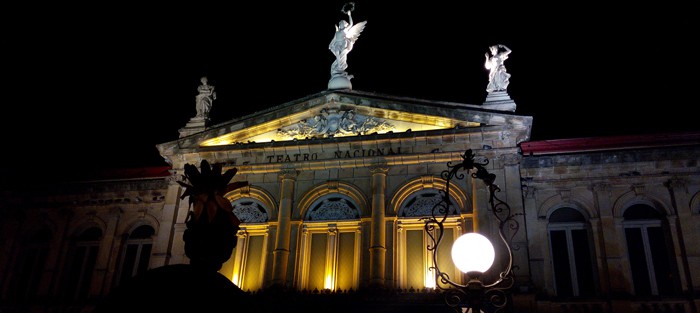Adriana Collado looked up at the ceiling. There’s a crack near the top of that pillar, she said, pointing to a column inside San José’s historic National Theater. And that was it: the worst damage inside the theater after this week’s powerful magnitude-7.6 earthquake.
That’s a decorative pillar, the theater’s architect William Monge added. A replica of a statue called “La Fama” also was tarnished (the original “La Fama,” also kept at the theater, was not harmed by the quake).
Still, that didn’t stop rumors from flying. Following the quake, an entire television crew from Channel 7 and reporters for the daily La Nación rushed to the theater.
“The National Theater is a structure that represents the emotional heart, in many cases, of national architecture,” said Collado, the theater’s director, explaining the rumors as a problem of “collective memory.” Citizens worry about the theater, built in 1897, because the last earthquake of a similar magnitude devastated it.
On April 22, 1991, a magnitude-7.6 earthquake hit the Caribbean city of Limón. The quake killed 47 people and left 10,000 homeless. The country suffered an estimated $160 million in damage, and the National Theater remained closed for two and a half years.
Since the Limón quake, tales of the next “Big One” dogged Costa Rica. Seismologists predicted that, sooner or later, a major earthquake would smash the Nicoya Peninsula, in the northwest part of the country.
That may have been the temblor that hit Wednesday. It was slightly weaker – 7.6 instead of 7.9 – than predicted, but still the strongest, or second strongest, earthquake in Costa Rican history, depending on the source. The quake was felt in Nicaragua and Panama. Some 1,000 aftershocks followed.
Preliminary data from the Costa Rican Social Security System and the Public Works Ministry (MOPT) estimate damage at $6 million. Most destruction occurred in the northwest province of Guanacaste. The local Red Cross fears the death toll could rise, but at press time only one death had been confirmed. A 51-year-old Guanacaste woman died of a heart attack when the temblor struck, although the National Emergency Commission said Thursday it would not count the death as an earthquake casualty. Some 20 people are injured.
But the effects of this earthquake were much less severe than they could’ve been. Leopold Linkimer, a seismologist of the National Seismological Network, said in spite of the fierce magnitude, other factors “mitigated the impact” of the earthquake, including Costa Rica’s adherence to seismic codes.
The epicenter, near Sámara, was far from major populations. The earthquake had a depth of 25 miles, a factor that tends to limit damage. Also, Nicoya is made up of much denser geological features than other parts of the country.
The deadliest earthquake in Costa Rica this millennium – a magnitude-6.3 temblor that hit Cinchona, just northwest of San José, in 2009 – killed close to three dozen people. It hit a more fragile part of the country, triggering landslides that buried victims.
Wednesday’s earthquake might not even be the deadliest natural disaster to strike Costa Rica this year. At the end of July, six people died in the Atlantic region due to flooding caused by heavy rains.
News of the earthquake spread around the world fast. A tsunami warning came and dissipated from news sites. On NBCNews.com, a headline screamed in all caps: “TWO DEAD AS STRONG QUAKE HITS COSTA RICA.”
But the attention-grabbing headlines did not imply gory details in the story. Reuters news wire noted that the epicenter was located near a $29.75 million mansion owned by Hollywood star Mel Gibson.
The strangest consequence of the quake was the cancellation of a concert, “Awesome 80’s Fest,” scheduled for Saturday in San José. Producers RPM TV consulted with the Health Ministry and decided to scratch the concert, starring ’80s icons Toto and Men Without Hats, after the earthquake.
Jim Batres of the Costa Rican Red Cross said lines were flooded with calls after the earthquake. But 80 percent of the calls were “panic attacks,” not reports of damage or injuries.
Despite some losses of electricity, phone lines and Internet, the country’s communications infrastructure held up well. The state-run Costa Rican Electrical Institute reported 13 million calls made in the first hour after the quake, four times the normal traffic.
Hospitals in the Central Valley suffered mild damage and mostly operated at full speed. Susana Saravia, communications director for San José’s Hospital Mexico, said doctors were receiving patients from Hospital Monseñor Sanabria.
National Emergency Commission President Vanessa Rosales refused offers of international aid. In 1991, assistance came from throughout the world. In the aftermath of the Cinchona quake, Costa Rica needed to borrow helicopters from the United States and Colombia to rescue trapped tourists. This time, Rosales insists, help was not needed.
Places like the National Theater were reinforced after the 1991 earthquake. Linkimer said that, compared to other places in the region, Costa Rica does a better job of following seismic codes.
The country does have fragile shantytowns and other vulnerable areas, Linkimer said. But on the Nicoya Peninsula, many variables were able to limit the impact of Wednesday’s quake.
“Costa Rica has relatively good structures.” Linkimer said. “I wasn’t expecting major damage from this.”







